- Prelude
- Editorial
- 'Public Sculptures are the Public's own Consciousness'
- Stimulating Thoughts
- Sculptural Traditions and Contemporary Art Practices
- Sculpting out a Third Dimension from Madhya Pradesh
- About Nostalgic Dragonflies and Homes in the Bags: Sculptural Snapshots from the North-East
- A Concise Chronicle of Bengal's Modern Sculpture
- Neo-sculptural Identity: Six Young Sculptors
- From Object to Experience: Notes on American Sculpture
- In the Domain of Drama Sculptures of S.Nandagopal
- Satish Gujral : Sculpting the Inner Form
- Transformation of Articulations: Mrinalini Mukherjee
- The Experiential Quotient in the Sculptures of Ravinder Reddy
- Shresta Rit Premnath A Passion for Structure
- The Anatomy of Melancholy: Sculptures of Rajesh P Subramanium
- A Crusader of/for Site Specific Public Art: Subodh Kerkar
- Installation Practices in and around Santiniketan
- A Wall is a Screen: A Promenade Film Street Performance
- Jaeger-LeCoultre An Overview
- Regency Style: Regency Furniture
- Designing the Streetscapes: Visual Elements of Pedestrian Corridors
- Sculpture Rules It All
- The Triumph of the Eternal
- Artist Index and Statistics- Anish Kapoor
- Auction Reports
- Musings from Chennai
- Art Bengaluru
- Art Events Kolkata: October-November 2010
- Mumbai Art Sighting
- An Evening of Interaction
- 6th Asian Museum Curators' Conference
- Swedish Art in India
- Couple of Difference : Recent sculptures of Karl Antao
- Previews
- In the News
- Sotheby's : Important Watches Geneva
ART news & views
A Concise Chronicle of Bengal's Modern Sculpture
Volume: 3 Issue No: 11 Month: 12 Year: 2010
by Prasanta Daw
In the domain of visual art India is best known for its wonderful sculptures from the Harappan and Mahenjo Daro civilization dating back nearly 5000 years. This streaming tradition of sculpture creation got almost suspended in the medieval period as the Mughal Emperors were against idol worshiping, 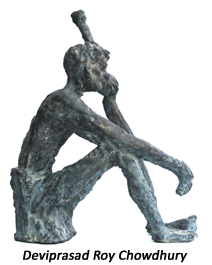 though painting and architecture reached a high aesthetical paramount. However, practice of sculpting as an art was revived in the colonial period, where western academic style of art was significantly dominant before the beginning of twentieth century. “School of Industrial Art” was established in 1854 and western academic art was much emphasized in the curriculum. On the other side affluent local inhabitants took pride in placing European paintings and statues in their houses or gardens, which was a part of western style of living. Consequently, the European style was adopted by a number of local sculptors such as Rohinikanta Nag (1868-1895), Kashinath Khatera (1876-1949), Fanindranath Bose (1888-1926), Pramathanath Mullick (1894-1983), Binayak Pandurang Karmakar (1891-1967) and Hiranmoy Roychowdhury (1884-1962).
though painting and architecture reached a high aesthetical paramount. However, practice of sculpting as an art was revived in the colonial period, where western academic style of art was significantly dominant before the beginning of twentieth century. “School of Industrial Art” was established in 1854 and western academic art was much emphasized in the curriculum. On the other side affluent local inhabitants took pride in placing European paintings and statues in their houses or gardens, which was a part of western style of living. Consequently, the European style was adopted by a number of local sculptors such as Rohinikanta Nag (1868-1895), Kashinath Khatera (1876-1949), Fanindranath Bose (1888-1926), Pramathanath Mullick (1894-1983), Binayak Pandurang Karmakar (1891-1967) and Hiranmoy Roychowdhury (1884-1962).
In such a milieu art of painting took a different direction under the leadership of Abanindranath Tagore (1871-1951) when he originated his new approach of painting at the turn of nineteenth century. It is known as 'Neo- Bengal School' of painting which spread almost across the whole country through his disciples. So Indian traditional painting was revitalized carrying a modern mark of identity. 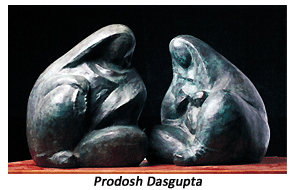 But unfortunately no such art movement was initiated in the realm of sculpture, and therefore further development of creative sculpture remained a bleak prospect.
But unfortunately no such art movement was initiated in the realm of sculpture, and therefore further development of creative sculpture remained a bleak prospect.
With the passage of time a spark of modern vision found expression in the works of Deviprasad Roy Chowdhury (1899-1975). It is evident in the half bust portrait of his father Umaprasad Roy Chowdhury in 1924, 'God of Destruction' (1934) and the tribute sculpture of his Guruji Abanindranath Tagore besides others. His perfection of skill and knowledge can be traced in the unique sculptures of 'Triumph of Labour' (1954), 'Martyrs Memorial' (1956), 'When Winter Comes' (1957), 'Martyr's Column' (installed after artist's demise in 1982), to name a few. His sculptures occupy a significant position in the history of Indian sculpture for its meticulous precision of anatomical details with high technical excellence'. Amongst the western artists, Epstein and Bourdle were highly esteemed by Deviprasad, but he considered Rodin as the greatest.
A versatile genius, Ramkinkar Baij had been an artist of dynamic temperament who enjoyed exploring new pastures in search of his new vocabulary. European art movements like impressionism, expressionism, surrealism, even abstraction boosted his artistic enthusiasm. 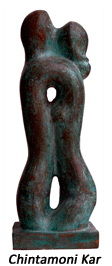 Probably Ramkinkar was the first Indian sculptor who appropriately employed abstract idiom in his creation, as evidenced in the outstanding composition of 'Lamp Stand' (1941). The sculptures like 'Sujata' (1935), 'Santhal Family' (1938) and 'Mill Call' (1956) represent the originality of Ramkinkar's thought and expression. Amongst others 'Katch and Debjani' (1929), 'Mithun' (1931), 'Harvestor' (1943) are noticeable sculptures as well, revealing a sense of primitive vigour and wild vitality, movement and monumentality. Moreover, it could be discerned that many of his concrete cement sculptures reflect rugged quality of the medium suggesting high standard of sculptural values. In fact, he was appropriately acknowledged by the art historians as the first successful modern sculptor of India.
Probably Ramkinkar was the first Indian sculptor who appropriately employed abstract idiom in his creation, as evidenced in the outstanding composition of 'Lamp Stand' (1941). The sculptures like 'Sujata' (1935), 'Santhal Family' (1938) and 'Mill Call' (1956) represent the originality of Ramkinkar's thought and expression. Amongst others 'Katch and Debjani' (1929), 'Mithun' (1931), 'Harvestor' (1943) are noticeable sculptures as well, revealing a sense of primitive vigour and wild vitality, movement and monumentality. Moreover, it could be discerned that many of his concrete cement sculptures reflect rugged quality of the medium suggesting high standard of sculptural values. In fact, he was appropriately acknowledged by the art historians as the first successful modern sculptor of India.
In continuation of the modernism, a few other sculptors of the country like Dhanraj Bhagat, P.V. Jankiram, Rajanikant Panchal, A.M. Daveriwalla, Raghav Kanoria, Balbir Singh Katt et al have also contributed creditably to the development of the Indian sculpture. A handful of Bengali sculptors too came forward with their fresh vision. Let us take note of some of them.
Prodosh Dasgupta (1912-1991) is one of those few sculptors who were enlightened by the twentieth century's global interpretation of art. The embodiment of his three dimensional works has a western bias, but the vital spirit is anointed with the alliance of classical Indian sculpture.  One can mark in his art works, the simplification of form and an attempt to bring a state of stability in weight and rhythm through mass and volume, and also the inspiration of Brankusi, Arp and Henry Moor. Though in the first phase of his creative journey, Epstein and Burdel had inspired him a lot. At a particular time of his career his works moved from concrete to abstract also. 'Bondage'(1943), 'Toilet' (1947), 'Egg Family' (1973), 'Cradle' (1950) are worth mentioning for their lively rhythmic expressiveness and anatomical volume and values.
One can mark in his art works, the simplification of form and an attempt to bring a state of stability in weight and rhythm through mass and volume, and also the inspiration of Brankusi, Arp and Henry Moor. Though in the first phase of his creative journey, Epstein and Burdel had inspired him a lot. At a particular time of his career his works moved from concrete to abstract also. 'Bondage'(1943), 'Toilet' (1947), 'Egg Family' (1973), 'Cradle' (1950) are worth mentioning for their lively rhythmic expressiveness and anatomical volume and values.
At heart a figurative sculptor, Chintamoni Kar (1915-2005) has harmoniously synthesized the sculptural elements of east and west. An emerging kinetic energy pervades the physical features of his figures, evoking palpably alive feelings. Kar has expressed his impressions in a variety of mediums, and also in different manners. The central truth about his themes is contained in a balanced blending of myth and reality. Sometimes he has adopted a symbolic approach, and has often carved out native and alien legends into mythical images. Time and again love for music of his early years finds expression in his rhythmic and vibrant figures. 'Cloud Messenger' (1949), 'Usha and Sabita' (1952), 'Skating the Stag' (1948), 'Sabita and Usha' (1993), 'Mithun' (1983), 'Nayika' (1960) and a series of mother and child and Buddha images in varied forms are notable for strikingly beautiful and faultless techniques used.
Another important sculptor Sankho Chowdhury (1916-2006) has received inspirations from various schools of art, but has not been directly influenced by any. On a minute observation of his retrospective works, one cannot fail to see that he is a research-minded artist. With an unprejudiced consciousness and alive to the spirit of his time he has created forms which are modern, though not untraditional. 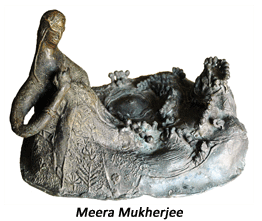 The most important aspects of his artistry are the mobility of the formations and deformations of trials and experiments with lines, plains and interplay of curves. Apart from formations he has rigorously experimented with unconventional material, such as coloured cement, ebony planks, copper, brass, aluminium sheet, stainless steel, smoked pine, thermocol etc. His significant sculptures include 'Cock' (1951), 'Head of a Girl' (1958), 'Seated Figure' (1956), 'Woman' (1960), 'Sringar' (1965), 'Music' (1966) , 'Chemist' (1961), 'Totem' (1965) and others.
The most important aspects of his artistry are the mobility of the formations and deformations of trials and experiments with lines, plains and interplay of curves. Apart from formations he has rigorously experimented with unconventional material, such as coloured cement, ebony planks, copper, brass, aluminium sheet, stainless steel, smoked pine, thermocol etc. His significant sculptures include 'Cock' (1951), 'Head of a Girl' (1958), 'Seated Figure' (1956), 'Woman' (1960), 'Sringar' (1965), 'Music' (1966) , 'Chemist' (1961), 'Totem' (1965) and others.
Sunil Paul (1920), a notable creative artist, cannot be said to be the product of any particular school of art, because ancient and modern art ideals of many countries have stirred up his visual art. His sculpture is manifold and reveals variety, such as realistic, idealistic, decorative etc. For instance, the statues of 'King Tribhuban' (1943) and 'Judha Samsher' (1943) are specimens of extreme realistic sculpture. 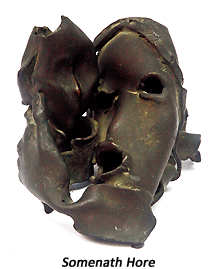 Another sculpture called 'Eureka' (1941) bears the evidence of influence of Rodin. 'The Two Women' reflects the Egyptian style, while 'Meghdoot' (1946) and some three dimensional representations of God and Goddess uphold the evidence of traditional Indian Art. In a word, the sculptures of Sunil Paul stand out as a holy confluence of various streams of art.
Another sculpture called 'Eureka' (1941) bears the evidence of influence of Rodin. 'The Two Women' reflects the Egyptian style, while 'Meghdoot' (1946) and some three dimensional representations of God and Goddess uphold the evidence of traditional Indian Art. In a word, the sculptures of Sunil Paul stand out as a holy confluence of various streams of art.
As a sculptor Meera Mukherjee (1923-1998) stands on a separate pedestal introducing absolutely marvellous forms of art and their technical methods. She has learnt the technique of 'Dokhra' process from the village artisans and has imbibed that tradition making some changes as per her own convenience. Her visual language is simple in expression charged with a vigour of rural art. Mainly myth and real life have been her main subjects. Another potential sculptor Uma Siddhanta (1933) has been devoted to the execution of organic beauty of human figures for a long time.
Essentially a painter, Somenath Hore (1921-2006), became absorbed in sculpture almost in an advanced age. His distorted and terribly thin hungry figures like 'Mother and Child' (1975-77) reflect the theme of starvation and social injustices. These distressed and twisted figures register a strong protest against establishment and social systems.  Subsequently the name of other two artists i.e. Sudhir Kashtagir and Bhabesh Sanyal may be recalled who have excelled in painting as well as sculpture with equal ease.
Subsequently the name of other two artists i.e. Sudhir Kashtagir and Bhabesh Sanyal may be recalled who have excelled in painting as well as sculpture with equal ease.
The above discussion clearly conveys how Indian sculptors have always tried to merge tradition with individual talents, coming out with new sculptural concepts. Their works exhibit significant artistic assimilations of western art philosophy into archaic Indian perceptions of art. Apart from embodying manifestations of life and nature their creations have been imbued with social consciousness. This dynamism has introduced a new insight to the creative process of art as a whole, and has acted as a stimulant to the development of Indian sculpture in a period of transmutation.
The sculptors of the next generations i.e. the 1960s have expanded the metamorphosis of their forerunners in multidimensional features. For instance, Ajit Chakraborty's (1930-2005) strong structural forms are massive, unrealistic and mostly characterized by surrealistic or abstract sign.  Sculptures by Sarbari Roy Chowdhury (1933) generally feature a blend of the academic realism and abstract quality creating distinctive style, apart from her other works done in different manners. In order to discover a modern look Madhav Bhattacharjee (1933) has turned from academic realism to machinery impact, from formal construction to architectural, and then again to the geometric abstraction. Physical beauty of the human anatomy has been bestowed in the configurations of Bipin Goswami (1934) in a simple embodiment related to mass, volume and space. Shankar Ghosh's (1934) sculptures are inspired by various facets of his environment that have importantly coupled with manifold human forms and shapes. Debabrata Chakraborty (1935) has created marvellous susceptible forms with logical arguments of aesthetics. Surajit Das's (1935) human figures in diverse expressions convey a variety of mood and movements. Niranjan Pradhan's (1940) sensitive executions are marked by swift motion of sharp spiral lines spreading all round the twisting figures evoked from vibrating tensions all over, sometimes with blending of concavity and convexity. In addition there are many sculptures like Haran Chandra Ghosh (1927) Raghunath Goswami (1933), Ranen Datta (1933), Subal Chandra Saha (1933), Samaresh Chowdhury (1934), Subhas Saha (1935), to name a few who have also contributed to the developmental process of modern Indian sculpure. Their perfection of knowledge and extraordinary skill can be traced in their multifarious aesthetic appeals. The important key note is the distortion of organic structures aiming to capture the inner feelings, tensions with an emphasis on global aesthetic perception.
Sculptures by Sarbari Roy Chowdhury (1933) generally feature a blend of the academic realism and abstract quality creating distinctive style, apart from her other works done in different manners. In order to discover a modern look Madhav Bhattacharjee (1933) has turned from academic realism to machinery impact, from formal construction to architectural, and then again to the geometric abstraction. Physical beauty of the human anatomy has been bestowed in the configurations of Bipin Goswami (1934) in a simple embodiment related to mass, volume and space. Shankar Ghosh's (1934) sculptures are inspired by various facets of his environment that have importantly coupled with manifold human forms and shapes. Debabrata Chakraborty (1935) has created marvellous susceptible forms with logical arguments of aesthetics. Surajit Das's (1935) human figures in diverse expressions convey a variety of mood and movements. Niranjan Pradhan's (1940) sensitive executions are marked by swift motion of sharp spiral lines spreading all round the twisting figures evoked from vibrating tensions all over, sometimes with blending of concavity and convexity. In addition there are many sculptures like Haran Chandra Ghosh (1927) Raghunath Goswami (1933), Ranen Datta (1933), Subal Chandra Saha (1933), Samaresh Chowdhury (1934), Subhas Saha (1935), to name a few who have also contributed to the developmental process of modern Indian sculpure. Their perfection of knowledge and extraordinary skill can be traced in their multifarious aesthetic appeals. The important key note is the distortion of organic structures aiming to capture the inner feelings, tensions with an emphasis on global aesthetic perception.
This streaming dynamism has diverted into myriad manifestations in the sculptors of the next generation i.e. the 1970's. Their explorations indicated a vital potential. Let us take an overview. One of the important sculptors of this period is Biman Bihari Das (1943). His works are vertical, suggesting upraised growth, whereas many others are composed in semi circles. It appears to emerge out of the combination of lines, spheres, circles and from the warp and woof of void and solid space. Dilip Saha, Manik Talukdar, Anit Ghosh are all contemporaries having been born in 1944, but their plastic art contains divergent values.  Dilip Saha's abstract configurations denote physchological subtlety and precision, whereas Anit Ghosh's abstract geometrical works maintain logical relations between time and space. Manik Talukdar predominatly portrays diverse expressive modalities of women's sensuality. Janak Jhankar Narzary (1948) conveys his realization through non-realist genres, where the physicality of the objects is de-contextualized. Another sculptor Gopal Prasad Mondal (1949) is working effectively for a long span of time to explore a new pasture in the tune of Micro to Macro organic sculpture. Simple childlike sculptures of Tarka Garai (1946) capture the rugged vitality of primitivism.
Dilip Saha's abstract configurations denote physchological subtlety and precision, whereas Anit Ghosh's abstract geometrical works maintain logical relations between time and space. Manik Talukdar predominatly portrays diverse expressive modalities of women's sensuality. Janak Jhankar Narzary (1948) conveys his realization through non-realist genres, where the physicality of the objects is de-contextualized. Another sculptor Gopal Prasad Mondal (1949) is working effectively for a long span of time to explore a new pasture in the tune of Micro to Macro organic sculpture. Simple childlike sculptures of Tarka Garai (1946) capture the rugged vitality of primitivism.
Difference in attitude and search of the sculptors of the succeeding generations can be detected in their artistic pursuits. As for instance, Bimal Kundu (1954), eschewing substantial mass and volume, builds up varied intriguing human and celestial figures alongside his other abstract configurations which are transmuted to new realms of meaning. He employs some unusual material, such as broken scrap wood, cheap leather etc. to mark a divergence of method. Bimal's colleague Sunil Kumar Das (1952) has ventured for mixed media almost from the beginning of his career successfully. Many characters and events germinate his ideas that take shape in combined mediums with fantastic look. Now-a-days many sculptors of the new generation prefer to use unconventional, sometimes useless material, in their sculptures. There are sculptors who are working really hard for exploring new sensibilities. Anil Sen (1951), Tapas Sarkar (1953), Shyamal Roy (1957), Rishi Barua (1958) Sudarshan Pal (1953). Pankaj Panwar (1961), Ram Kumar Manna (1961) and Sandip Chakraborty (1961) figure prominently among this new breed of sculptors.
In fact, it is the time of transmission, gradually opening up a new vista which is challenging the established practice. Mass and volume, monumentality and massiveness are not always momentous, even irrelevant details have been eliminated keeping an eye to bringing out inner pure form of the object. Therefore images are not always faithful to realistic approach, these are sometimes distorted or deformed, sometimes elongated or abnormal. Besides the eternal themes like human and social problems, themes like global chaos and crisis are progressively drifting into the Indian sculptors' creative focus.